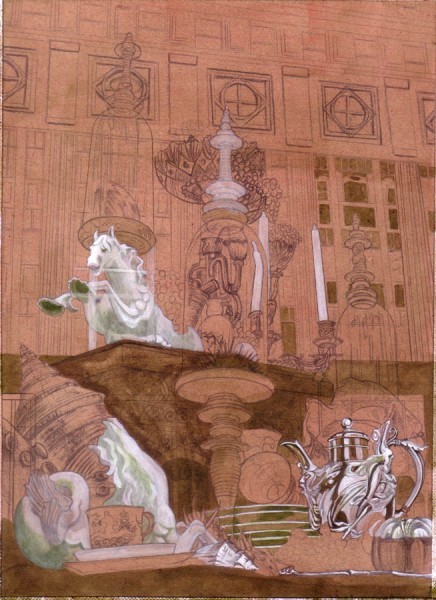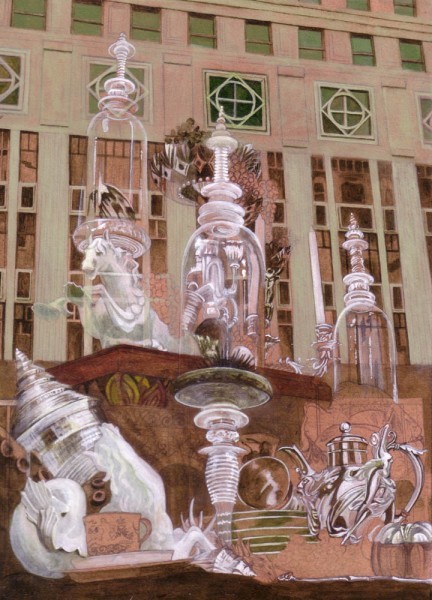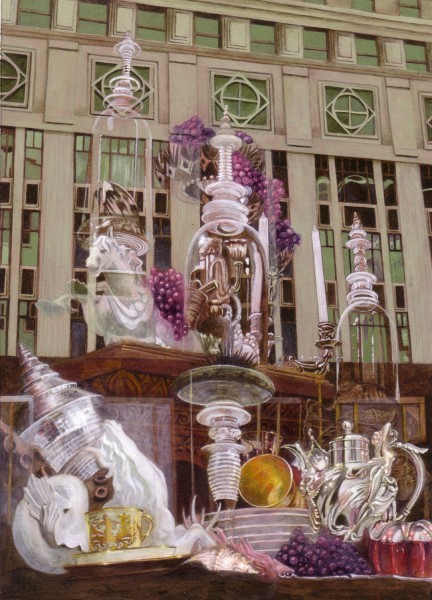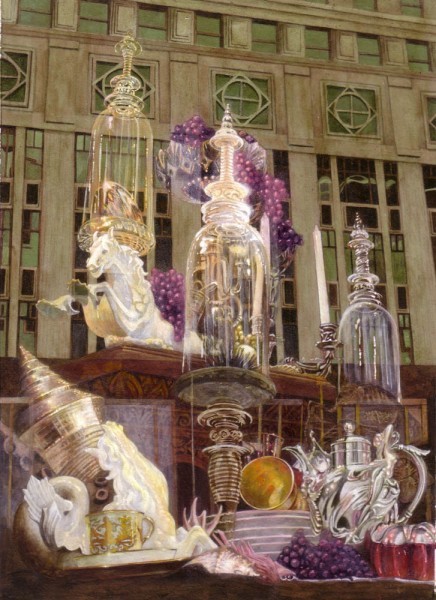A Painter’s Glaze
People ask about my acrylic painting process, I guess you could call it “Glazing“. Kathrine Sandoz, one of my professors at SCAD, taught me and I kind of ran away with it. So here is a demo or at least a visual process. The application falls loosely somewhere between Durer or Titan. An excellent book of reference on the subject is “How To Paint Like the Old Masters” by Joseph Sheppard.
I mostly documented this process for myself, since I seem to suffer amnesia immediately after completing a painting of this kind. Starting a new one, I cannot remember how I did the last. I’ve completed 5 of the series and I am almost finished with the 6th. It’s really like the movie Memento every time I start. Let me share the confusion with you and spread the love :D
This painting is titled “The Feast” you can view the entire series here.
I start with a very detailed drawing, somewhat with rendered values, especially where the focus is. The more I do these however, the less I am concerned with too much perfect drawing.
I then lay down a mid tone wash, usually of burnt orange and begin establishing a monochromatic under painting. I first establish my values by layering white and “black”. I will eventually be glazing color over top of the established values. For my “black” I am mixing burnt umber, prussian blue, and sap green with a little matte medium.
(the general rule waiting to be broken is that the wash should be a compliment to, and opposite in temperature of what your finished overall color sceme will be. For example, here I plan for this to finish in a seedy, cool green. So I washed in a warm red. This under painting will pop the glazes of green to follow.)
I continue to pull whites and fill in the darks. Here it’s a chalky light green I’ve made with gesso, sap green and burnt umber. I use gesso as my initial white because I will need the added tooth it provides for the million glazes I am about to lay down. Acrylic can get smooth and no longer accept layers. If this happens, but you don’t want the chalky whites in transparent shadows, you can add matte medium which is transparent and will give you a little more tooth to keep going.
With much of the under painting in place I can start glazing in the local color. I will continue to manipulate the values, as they change with the addition of color, and will require adjusting. Keep in mind the colors are still very thin, I add matte medium to them and alternate color with thin white and “black” to establish form. It’s a slow process but luminous depth will be the result.
At this point there is a lot of blending. Dry brushing lights over shadows (as seen in the lower left porcelain horse) glazing in a little reflected light (lower left corner on the tea cup), adding stronger highlights and blending ( lower right corner on the silver tea pot). I then keep building the darks and glazing over with green.
The values are pretty well established it’s time for that constant push and pull of glazing in warm and cool to make the lights luminous and turn shadows on forms. This process can take forever, and often I undo a really brilliant wash and have to go back over and over with more warm glazes and white.
I’ll glaze in a few more green, over-all washes using either sap green or quinacridone gold. This will set my mid tones and dark shadows. For my bright, glowy lights, I generally mix a thin glaze of cadmium yellow, burnt orange and maybe a little alizarin crimson . I glaze this over the brightest highlight points, then go back over it with thick white and then glaze again and back and forth until I am happy with it.
It can take a long time and lots of thin layers of paint but you get a rich bright painting. I am always happy when I finish one but starting one is very daunting.
The 6th is almost complete after which, I think I will toss this technique for a more direct painting approach. Something more along the lines of this and this oooo and this.
Other fine resources on this subject are: http://smartflix.com/ you can rent DVD’s on just about anything you want to learn here http://www.artistsnetwork.com/audiovideo/ you can buy small video clips to help with specific topics here http://www.conceptart.org/ you can look at great work and ask the forum here









